Lecture 5: More Images
June 28th, 2021
Today: image co-ordinates, range, nested range, make drawing to figure out co-ords
Coding Style 1.0 - Tactics
CS106A doe not just teach coding. It has always taught how to write clean code with good style. Your section leader will talk with you about the correctness of code, but also pointers for good style.
All the code we show you will follow PEP8, so just picking up the style tactic that way is the easiest.
Python Guide Style-1, we'll pick out a few things today, re-visit it for the rest later.
Review from Thursday
Image Foreach Operation
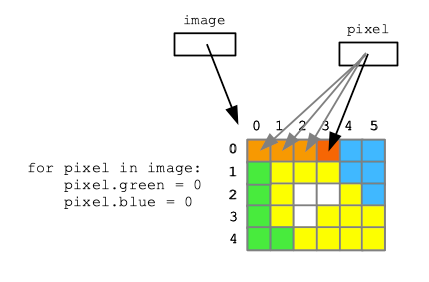
Recall: image.get_pixel(x, y)
# For the pixel at x=4 y=2 in "image", # set its red value to 0 pixel = image.get_pixel(4, 2) pixel.red = 0
Recall: range(n)
Example: Darker-Nested
Here is a version of our earlier "darker" algorithm, but written using nested range() loops. The nested loops load every pixel in the image and change the pixel to be darker. On the last line return image outputs the image at the end of the function (more on "return" next week). Run it to see what it outputs. Then we'll look at the code in detail.
def darker(filename):
image = SimpleImage(filename)
for y in range(image.height):
for x in range(image.width):
pixel = image.get_pixel(x, y)
pixel.red *= 0.5
pixel.green *= 0.5
pixel.blue *= 0.5
return image
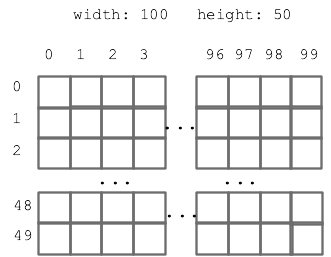
1. for y in range(image.height):
Say the image height is 50. Then range(50) is the series 0, 1, 2 .. 49. Which is all the y values for this image, from top to bottom. The loop runs the y variable through 0, 1, 2 ... 49, one number for each iteration.
2. for x in range(image.width):
Say the image width is 100. The range(100) is the series 0, 1, 2 .. 99 which are the x index numbers from left to right. The loop runs the variable x through 0, 1, .. 99, one number for each iteration.
3. Loop Nesting
Here is a picture, showing the order the nested y/x loops go through all the pixels - all of the top y=0 row, then the next y=1 row, and so on.
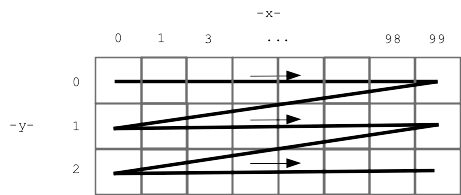
Nested y/x - Idiomatic
The nested y/x loop code has a lot of detail in it. The good news is, writing the loops this way to hit every pixel in an image is idiomatic. It's the same every time, so you can use it as a unit while you get used to its details.
How to Make 2 Pixels Look The Same?
![]()
# Make pixel b look the same as pixel a b.red = a.red b.green = a.green b.blue = a.blue
How to Create a New, Blank Image?
Thus far the code has changed the original image. Now we'll create a new blank white "out" image and write changes to that.
image = SimpleImage(filename) # 1. create a blank white 100 x 50 image, store in variable named "out" out = SimpleImage.blank(100, 50) # 2. More realistic, create an out image the same size # as the original out = SimpleImage.blank(image.width, image.height)
Code With Two Images - getPixel()
In the code below, we have two images "image" and "out" - can get a pixel in either image how? The key is which image is before the dot when the code calls get_pixel().This is the essence of noun.verb function call form. Which image do we address the get_pixel() function call to?
# a points to pixel (10, 0) in original image a = image.get_pixel(10, 0) # b points to pixel (10, 0) in out image b = out.get_pixel(10, 0)
Example: Darker Out
Establish the basics on this one, do something interesting on the next one.
Darker algorithm, but creating a separate out image.
def darker(filename):
image = SimpleImage(filename)
# Create out image, same size as original
out = SimpleImage.blank(image.width, image.height)
for y in range(image.height):
for x in range(image.width):
pixel = image.get_pixel(x, y)
pixel_out = out.get_pixel(x, y)
pixel_out.red = pixel.red * 0.5
pixel_out.green = pixel.green * 0.5
pixel_out.blue = pixel.blue * 0.5
return out
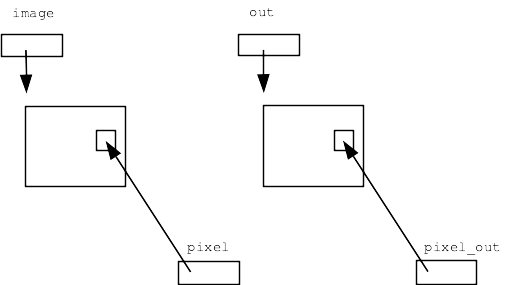
Exercise - Aqua Stripe
For the Aqua Stripe problem, produce an image with a 10 pixel wide aqua stripe on the left, with a copy of the original image next to it, like this:
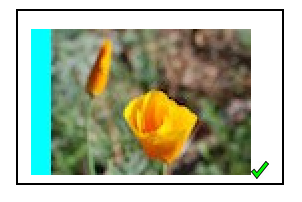
Drawing to think about coordinates...
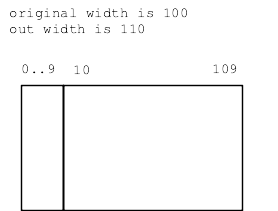
1. Make out image - 10 pixels wider than original
out = SimpleImage.blank(image.width + 10, image.height)
2. Produce the aqua stripe
3. Loop To Copy Over Original - Drawing!
How to copy the data from the original to the right side of the output? Need to think about the x,y values, which are not the same in the two images.
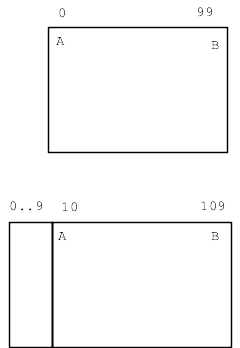
For x,y in original, what is the corresponding x,y in out?
Make a little chart (here "x" means in the original image)
pt x x_out A 0 10 B 99 109What's the pattern? x_out = x + 10
Now we can write the key get_pixel() line below, to figure pixel_out for each original pixel.
Aqua Stripe Solution
def aqua_stripe(filename):
"""
Create an out image 10 pixels wider than the original.
(1) Set an aqua colored vertical stripe 10 pixels wide
at the left by setting red to 0.
(2) Copy the original image just to the right
of the aqua stripe. Return the computed out image.
"""
image = SimpleImage(filename)
# Create out image, 10 pixels wider than original
out = SimpleImage.blank(image.width + 10, image.height)
# Create the 10-pixel aqua stripe
for y in range(image.height):
for x in range(10):
pixel_out = out.get_pixel(x, y)
pixel_out.red = 0
# Copy the original over - make drawing to guide code here
for y in range(image.height):
for x in range(image.width):
pixel = image.get_pixel(x, y)
pixel_out = out.get_pixel(x + 10, y) # the key line
pixel_out.red = pixel.red
pixel_out.green = pixel.green
pixel_out.blue = pixel.blue
return out
Experiments: try +11 instead of +10 - get bad-coord exception, Try +9, and image shifted slightly to left, can try the diff-stripes slider.
Strategy
It's hard to write that get_pixel() line just doing it in your head. We make a drawing to get the details exactly right.
Concrete Numbers
Notice that our drawing was not general - just picking width = 100 as a concrete example. A single concrete example was good enough to get our thoughts organized, and then the formula worked out actually was general.
Off By One, OBO
A common form of error in these complex indexing algorithms is being "off by one", like using x = 100 when x = 99 is correct.
Example - Mirror1
> Mirror1
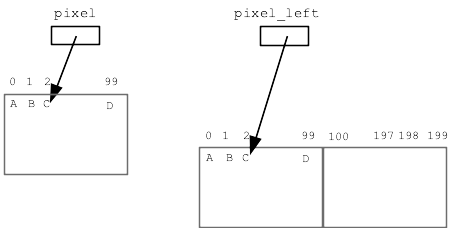
def mirror1(filename):
image = SimpleImage(filename)
# SimpleImage.blank(width, height) - returns a new
# image with size given in its 2 parameters.
# Here, create out image with width * 2 or first image:
out = SimpleImage.blank(image.width * 2, image.height)
for y in range(image.height):
for x in range(image.width):
pixel = image.get_pixel(x, y)
# left copy
pixel_left = out.get_pixel(x, y)
pixel_left.red = pixel.red
pixel_left.green = pixel.green
pixel_left.blue = pixel.blue
# right copy
# nothing!
return out
Exercise - Mirror2
> Mirror2
This a favorite example, bringing it all together. This algorithm pushes you to work out details carefully with a drawing, and the output is just neat.
Mirror2: Like mirror1, but also copy the original image to the right half of "out", but as a horizontally flipped mirror image. So the left half is a regular copy, and the right half is a mirror image. (Starter code does the left half).
Mirror2 Strategy
I think a reasonable reaction to reading that problem statement is: uh, what? How the heck is that going to work? But proceeding carefully we can get the details right. Don't do it in your head.
Make a drawing of the image coordinates with concrete numbers, work out what the x,y coordinates are for input and output pixels. We'll go though the whole sequence right here.
Here are 4 points in the original: A: (0, 0) B: (1, 0) C: (2, 0) D: (99, 0) Sketch out where these points should land in the output. What is x value for pixel_right for each of these?
Sketch out ABCD Values
Try completing drawing with ABCD values. This is a great example of slowing down, working out the details. We start knowing what we want the output to look like, proceed down to the coordinate details.
mirror2 Solution Code
def mirror2(filename):
image = SimpleImage(filename)
out = SimpleImage.blank(image.width * 2, image.height)
for y in range(image.height):
for x in range(image.width):
pixel = image.get_pixel(x, y)
# left copy
pixel_left = out.get_pixel(x, y)
pixel_left.red = pixel.red
pixel_left.green = pixel.green
pixel_left.blue = pixel.blue
# right copy
# this is the key spot
# have: pixel at x,y in image
# want: pixel_right at ??? to write to
pixel_right = out.get_pixel(out.width - 1 - x, y)
pixel_right.red = pixel.red
pixel_right.green = pixel.green
pixel_right.blue = pixel.blue
return out
Debugging: Put in a bug
Remove the "- 1" from formula above, so out_x value is one too big. A very common form of Off By One error. What happens when we run it?
Debugging Rule #1 - Read The Exception Message
An exception is an error cause by a line of code that halts the program at that point. The exception will have a message describing the low-level error, like a bad coordinate, and it will give a line number.
Just with those two facts - look at your code. Why is the code doing that? Sometimes just being pointed at the right line is enough for you to spot the bug.